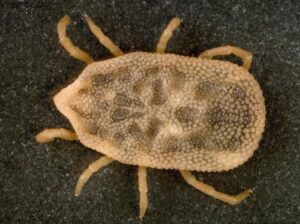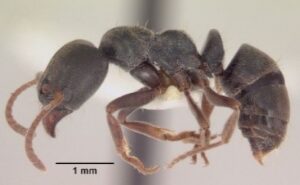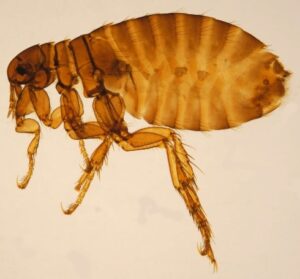Introduction
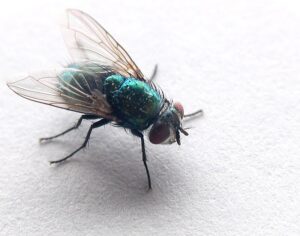
Most fly species (order Diptera) are relatively small, with soft bodies; some are very delicate, but many of them are of great economic and health importance. Among the blood-sucking species are black flies, horse flies, stable flies, and others, all of which are pests that are harmful to humans and animals. Many types of flies suck blood, and some of them prefer dead bodies and droppings, such as house flies and metal flies. Some species are disease vectors, as these species transmit and spread germs that cause diseases like yellow fever, filaria, dengue, sleeping sickness, typhoid fever, dysentery, etc. Some flies are considered agricultural pests.On the other hand, there are many types of flies that are useful for feeding on corpses, and others are important predators or parasites on various insect pests. Other fly species help pollinate useful plants, and some are enemies of harmful weeds.
A large proportion of fly larvae live in all different aquatic environments, such as streams, ponds, lakes, and temporary water bodies, as well as in semi-fresh and alkaline waters. The larvae that feed on the plant live inside some of its tissues, either as tunnel makers in the leaves, inducing plant tumors, piercing the stems, or gnawing the stems. Predatory larvae live in many different environments: in water and soil, under bark or stones, or on green plants. Many species feed during their larval stage on decomposing plant or animal matter. Some fly larvae live in the swamps around crude oil pools, and other species breed in salt lakes. As for the full stages, they feed on various plant and animal juices, such as nectar, plant juice, and blood.
Most Common Fly Species in the UAE:
- Blow Flies – Calliphora, Chrysomya spp., Lucilia spp., Phormia spp. (Calliphoridae: Diptera)
- Drain Fly, Moth Fly, Sewage Fly, or Filter Fly – Clogmia albipunctata Williston (Psychodidae: Diptera)
- Face Fly – Musca autumnalis De Geer (Muscidae: Diptera)
- Flesh Fly – Sarcophaga (Sarcophagidae: Diptera)
- Fruit Fly, Drosophila Fly, Lesse Fruit Fly, or Vinegar Fly – Drosophila melanogaster Meigen (Dorosophilidae: Diptera)
- Fungus Gnat (Dark-Winged) – Sira (Sciaridae: Diptera)
- House Fly – Musca domestica Linnaeus (Muscidae: Diptera)
- Little house Fly – Fannia canicularis (Linnaeus) (Muscidae: Diptera)
- Phorid Fly or Humpbacked Fly – Megaselia scalaris (Loew) (Phoridae: Diptera)
- Sand Fly, No-See-Ums, or Black Gnat – Phlebotomus papatasis Scopoli (Psychodidae: Diptera)
- Stable Fly – Stomoxys calcitrans (Linnaeus) (Muscidae: Diptera)
Blow Flies:
General Description

Blue Fly Credit: John Talbol |
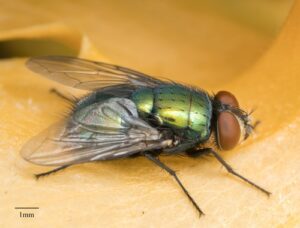
Green fly Credit: glmory – inaturalist.org |
- Adults of blow flies are about the size of house flies or slightly larger and have a bright metallic blue or green coloration.
- The mouth parts are sucking type.
- The veining of the wings is similar to that of the house flies.
- The adult blue fly, Calliphora, is slightly larger than the house fly, with a bright blue color on the abdomen and dull on the thorax.
- The green fly, Lucilia, is about the size of a house fly or slightly larger, bluish-green, or yellowish in color.
- The striped green flies. Chrysomyia, are about the size of the house flies or slightly larger. It is a bright emerald green color that may be tinged with bluish or yellow.
Life Cycle and Common Characteristics
- These flies deposit eggs upon animal carcasses and meat products causing them to “bottle” or be “blown” with
- They are common in most urban areas and are often abundant in garbage dumps, slaughterhouses, and meat processing
- They have long flight ranges and a strong sense of smell which guides them to dead animals and other attractants, even when located in distant
- Eggs may be deposited on living animals, although clean, healthy animals are rarely
- The larvae, upon emerging from the eggs, feed for a short time upon the surface of the food near the egg mass, when fully developed, they leave the breeding area and burrow into the
- The puparium is formed within a few days and emergence happens from 10 to 12 days after
- The life cycle of blow flies typically takes 3 – 4 weeks depending on the species
Damages and Medical Implications
- The blue flies, Calliphora, prefer to breed in garbage inside gardens, desert lands, and homes. Adult insects are attracted to rotting flesh, feces, and fruit stalks.
- The green flies, Lucilia sericata, are common flies in various environments found in slaughterhouses, markets, and garbage heaps. Adults are attracted to dead carcasses, open wounds, sheep’s fur, and to a lesser extent, fecal waste, where the larvae develop. And cause a rattle in sheep in some areas.
- The green flies, Lucilia cuprina, feed on fallen fruits and on nectar and honeydew secreted by aphids. The female needs a meal of protein for the eggs to mature, and this can be provided by feeding on the feces of sheep and other animals, or on dead bodies.
- The striped green flies. Chrysomyia, are widely spread and are found in slaughterhouses, markets, garbage heaps, and inside dwellings. They are disturbing insects in homes, markets, and restaurants, and they cause many problems for animals and humans.
- Blow flies serve as mechanical vectors of disease organisms in the same way as house flies.
- Adults attracted to decaying flesh, carrion & Other species belonging to the genera Calliphora, Chrysomyia & Lucilia are involved in myiasis (the infestation of a live mammal typically from an infected sore).
- Not normally involved with diseases, but may spread bacteria (e.g. anthrax).
- Blow flies are a key component in forensic entomology (murder cases) and wound treatment in wartime.
- Drain Fly, Moth Fly, Sewage Fly, or Filter Fly:
General Description
| · Adults are about 1-2.5 mm long (about one-third the size of a housefly), with a light gray or tan body and lighter-colored wings.
· Both the body and the wings are densely covered with long hairs that give the body a fuzzy appearance, hence the name moth fly. · When at rest, the wings are folded over the body in a characteristic roof-like manner. |
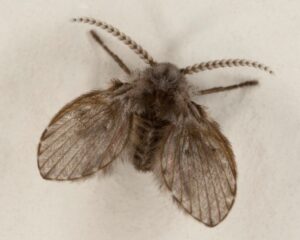
Credit: Sanjay Acharya, bugguide.net |
- Adults have long drooping antennae.
- The larva is slender, white to creamy brown with a distinct head, well-developed mouthparts, and a visible
- The body of the larva has 11 segments, with the last two containing paired breathing
- The pupa is yellow to brown, with two respiratory horns protruding from its
Life Cycle and Common Characteristics
- The female lays up to 100 eggs, and irregular masses of 15 to 40 eggs are most
- Females lay eggs in wet or moist soil, on sides of drains, on decaying organic matter, such as sewage plants, filthy dumpsters, water traps in plumbing fixtures, and garbage disposal units, and almost anywhere decomposing organic materials are found.
- The female does not lay eggs on dry surfaces.
- Eggs will hatch in less than two
- The life stages last around 9 to 15
- Dormancy occurs most frequently during the larval stage, but can also occur during the egg and pupal
- Pupae require 1-2 days before emerging as an
- Males emerge before females and live only a few
- Females that have not laid eggs can live up to seven
- Drain flies complete their life cycle in 3 to 4 weeks. Under favorable circumstances, the flies can go through one generation in as little as one week.
- Drain flies are usually seen swarming around and resting on the walls of bathrooms, building exteriors, and showers near suitable larval
- The source of the fly infestation is generally from sinks and floor drains, on walls near plumbing fixtures, on the sides of tubs and showers, from nearby sewage plants, or waste disposal Polluted waters and wet organic materials are preferred breeding areas of the fly.
- Flies occurrence is associated with standing water which can develop in any area with standing water with organic
- The larvae can be found feeding on the film of wet organic material that can accumulate in
Damages and Medical Implications
- Drain fly is an annoying and troublesome pest that concerns numerous
- In homes, adults are found on the walls of the bathroom, kitchen, or basement.
These flies are non-biting and are not capable of transmitting any known pathogens, and are of little economic importance. - Drain flies that breed in sewage do not transmit human disease.
- Large fly infestations can cause respiratory problems due to the possibility of inhaling fine hair-like scales that can fall off their bodies and
- Face Fly:
General Description

Credit: TristramBrelstaff |

Credit: James Lindsey |
- The face fly is similar to the closely resembles the house flybut is slightly larger,
- They are about 7–8 mm long.
- Adults are grey in color with four dark stripes on the thorax, with a grey-black patterned abdomen.
- The eyes in males almost touch when viewed from above.
Life Cycle and Common Characteristics
- Females deposit eggs only in newly deposited manure from cattle on rangeland or pasture.
- Eggs hatch within hours after deposition.
- The larvae are yellow in color. They pass through three larval stages, growing to about 12 mm long, then developing into white pupae.
- Adults emerge after 10 to 20 days of egg deposition.
- Adults emerge from winter hibernationfrom March to April.
- They feed on manure juices and plant sugars, and on secretions around the eyes, mouth, and nostrils of horses and cattle.
- They also feed on the host’s blood through wounds caused by orse-fly
- Most of the flies on the host are females searching for protein sources.
- Male flies feed only on nectar and dung. They rest on branches and fences, attempting to catch a female and mate
- At night, both sexes will rest on vegetation.
- The life cycle (Egg to adult) takes about 3 weeks
Damage and Medical Implications
- Female face flies typically cluster around the host animal’s eyes, mouth, and muzzle, causing extreme annoyance.
- Face flies are economically important to livestock producers since they transmit eye diseases and parasites to cattle.
- Contaminated females can transmit infectious bovine keratoconjunctivitis (pinkeye) and bovine rhinotracheitis to their hosts.
- They are the source of nematode eye worm, Thelasia rhodesi, and infections in horses and cattle.
- The female face fly’s persistent feeding habits produce significant annoyance and irritation.
- The cattle’s defensive behavior can affect grazing patterns.
- Flesh Fly:
General Description
| · Flesh flies are larger than house flies (up to three times larger).
· Adult flesh flies are a light grayish in color and have a gray-and-black checkerboard pattern on their abdomen and three dark longitudinal stripes on the thorax. · Longitudinal, strong bristles are present only on the posterior part of the abdomen. |
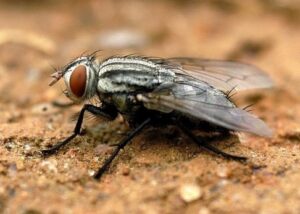
Credit: Saleem Hameed |
- The mouth parts are of the licking type.
- The veining of the wings is similar to that of the house fly.
- The eyes are red in color.
- On the abdomen there are greenish or silver spots that differ in appearance depending on the light reflections on them. The end of the abdomen in the male is brown.
Life Cycle and Common Characteristics
- Flesh flies are ovoviviparous (the larvae hatch inside of their mother’s “uterus” and are held until a proper host is found).
- The eggs undergo full development and hatch within the
- The female deposits the 1st instar larvae
- Within 5 days, the larvae will be in their 3rd instar and be near to
- The larvae leave the host to find a suitable location to pupate.
- Pupation starts one week after the larvae find the new location.
- Adults emerge after 10
- These flies depend on live or dead tissue to complete their life
- Flesh flies are often very numerous in populated areas, but seldom enter houses or food-handling establishments in significant numbers.
- Females of many species lay living larvae on meat scraps, decayed flesh, or on dog excrement.
Damage and Medical Implications
- Some flesh fly species are parasitoids, while most have been found on different types of carrion it is known as a carrion-inhabiting species, and they have been reported to cause myiasis in It also has a significant impact in other areas of science including parasitology and forensic entomology
- Flesh flies occur in places not suitable for most They are closely associated with humans (synanthropic) and they have been known to enter houses to colonize dead bodies.
- This family of flies is attracted to many types of dead vertebrate remains, including
- Myiasis is caused by the larvae of necrophagous flies (including flesh flies, blow flies, and screw flies) invading the organs and tissues of warm-blooded vertebrate animals and
- Those parasites larvae mainly stayed in the mouth, eyes, nose, subcutaneous tissues, skin, stomach, intestines, urinogenital system, ears, and other soft tissues of the
- In addition to the medical importance of flesh flies also known as mechanical vectors of parasitic disease agents, they can cause myiasis in the hospital environment which are also called nosocomial myiasis, and can be considered an indicator of wound care neglect, either by the nurses or by oneself.
- Flesh flies are important due to their strong adhesion to humans and may cause intestinal stigmatization, as well as staging injuries to animals.
- Fruit Fly, Drosophila Fly, Lesse Fruit Fly, or Vinegar Fly Fly:
General Description
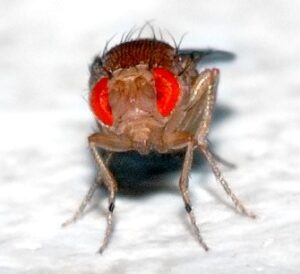
Credit: André Karwath |
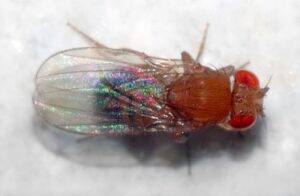
Credit: André Karwath |

Credit: André Karwath |
- Adults are 4mm long, yellow-brown, with brick-red eyes and transverse black rings across the abdomen.
- The front portion of the body is tan, and the rear portion is
- Females are about 2.5 mm long; males are slightly smaller with darker backs.
Life Cycle and Common Characteristics
- The life cycle of a fruit fly is a complete metamorphosis, meaning the life cycle includes an egg, larval, pupa, and finally emergence as a flying
- Eggs are about 0.5 mm long.
- The larval stage has three The generation time varies with temperature.
- The whole life cycle is relatively rapid and takes only approximately 10–12 days at room
- Both males and females have multiple sexual partners at the same time.
- Females lay about 400 eggs, about five at a time, near the surface of fermenting foods or other moist, organic
- Eggs hatch after 12–15 hours.
- The first instar larva begins feeding after egg hatching. Their feeding and growth phase lasts for four At the end of third instar stage, the larvae stop feeding and leave the food in search of an area for pupation.
- During the pupa stage, metamorphosis occurs for four days, following which adult flies
- Adult females are normally larger than adult male
- Females are ready to mate in less than 24 h after their emergence and can lay up to 100 eggs per
- Adult flies live about two months after
- Adults can fly in from outside through inadequately screened windows and
- The shortest development time (egg to adult) is 7 days at 28 °C
Damages and Medical Implications
- Fruit flies are primarily nuisance
- They are common in homes, restaurants, supermarkets, and wherever else food is allowed to rot and
- Fruit flies are especially attracted to ripened fruits and vegetables in the
- They breed in drains, garbage disposals, empty bottles and cans, trash containers, mops, and cleaning
- They have the potential to contaminate food with bacteria and other disease-producing
- Fungus Gnat (Dark-Winged):
General Description
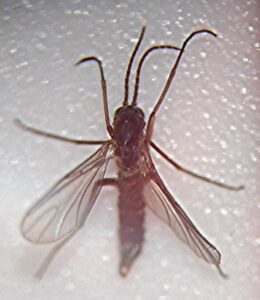
Credit: Peter Rühr |
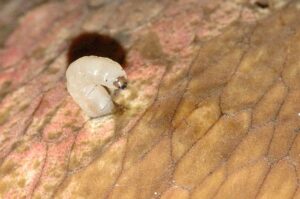
Credit: James Lindsey |
- Fungus gnats are distinguished from fruit flies because of their darker
- They are usually less than 5 mm long and short-lived gnats.
- These flies are sometimes confused with drain flies.
- The adults are 2–8 mm long.
- Larvae are slender and lack legs.
- Larvae are white (except for a black head), lender, and lack legs.
- The skin of the larva is slightly transparent so the contents of the gut are visible.
Life Cycle and Common Characteristics
- Fungus gnats are the most common houseplant
- They are found in wet plant soil, in sewer areas, and in household
- They are weak fliers and are seen walking rapidly over plants and soil, rather than flying.
- Fungus gnat larvae usually are located in the top 5-7 cm of the growing medium, depending on moisture
- They feed on fungi, algae, decaying plant matter, and plant
- Larvae develop rapidly and are fully grown in 2-3
- Larvae pupate from July to August, in or on the growing
- Adults emerge about one week
- Adults are weak fliers and fly in erratic
- In homes, they usually are seen in the near vicinity of an infested
- Adult life span is 5-10 days.
- Females may lay up to 200 transparent eggs into the cracks and crevices of growing
- Adults do not bite but may drink water residing on plant leaves and/or on the surface of growing media
Damages, Economical and Medical Implications
- Fungus gnats are nuisance insect when present in noticeable numbers, but the adults are harmless and do not
- Adults are occasionally pollinatorsof plants and carriers of mushroom spores.
- Adults also may carry diseases such as pythium(which causes “damping-off” to kill seedlings) on their feet.
- The gnats may be quite annoying to humans by flying into their faces, eyes, and noses, both indoors and outdoors. This is because adults are attracted to CO2)
- Larvaefeed on fungi growing on soil, helping in the decomposition of organic matter.
- Larvae tunnel into the stalks of the mushrooms and causing mushrooms to become brown and leathery.
- Fungus gnats are usually associated with the fungus and algae growths found around air conditioning pipes at which the moisture and improper drainage of the air conditioning system may produce asignificant amounts of fungus and algae that attract gnat flies inside homes and annoy Thus, when gnat fly problem occurred you must check indoor houseplants and air conditioning system.
- House Fly:
General Description

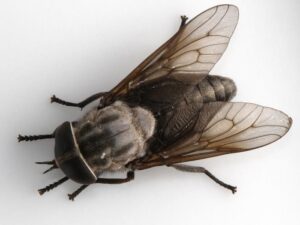
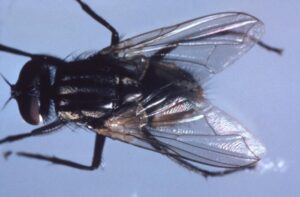
- The house fly adult length is about 6 to 7 Female adults are usually larger than males. The female can be distinguished from the male by the relatively wide space between the eyes (in males, the eyes almost touch). The head of the adult has reddish eyes and sponging mouthparts. The adult has the fourth wing vein sharply angled, and four lengthwise dark stripes on the top of the thorax. Its face has two velvety stripes that are silver above and gold below. The abdomen is grey or yellowish with a dark midline and irregular dark markings on the sides. The underside of the male is yellowish
- The eggs are white, small, oval eggs, and about 2 mm in length.
- Early instar larvae are 3 to 9 mm long, typically creamy whitish in color, and cylindrical but acuminate toward the The head contains one pair of dark hooks. The posterior spiracles are slightly raised and the spiracular openings are zigzag in shape which is completely surrounded by an oval black border.
- House fly pupa is about 8 mm
- Pupa is formed from the last larval skin which varies in color from yellow, red, and brown, to black as the pupa The shape of the pupa is quite different from the larva, being bluntly rounded at both ends.
Life Cycle and Common Characteristics
- The common house fly is a worldwide pest. It received its common name from being the most common fly found in and around homes.
- The house fly is a well-known global pest of both farms and
- The female lays egg in breeding sites that will provide sufficient moisture for larvae or maggot, they lay eggs in nearly any moist medium such as garbage or animal manure.
- Each adult female begins laying eggs a few days after hatching, laying a total of five to six batches of 75 to 100 eggs (can lay up to 500 eggs)
- The number of eggs produced is related to the female size which, itself, is especially a result of larval
- In warm weather eggs hatch in 12 to 24 hours into cream-colored larvae that burrow into the food material on which they hatched.
- Larvae grow and pupate in 4 to 7 days in warm weather.
- The larva development has three instars and the fully grown maggot is 7 to 12 mm
- The mature larva usually migrates away from its breeding source, seeking a dry place to pupate.
- Pupae complete their development in 2-6
- The emerging fly gets away from the pupal case using an alternately swelling and shrinking sac, called the ptilinum, on the front of its head which it uses like a pneumatic hammer to break through the
- Adults are ready to mate within a few hours after emerging.
- During warm weather, two or more generations may be completed in a month.
- Fly population builds up and is greatest in the early fall months.
- Animal manure, human excrement, garbage, decaying vegetable material, and ground contaminated with such organic matter are suitable materials.
- They are attracted to a wide variety of food materials, but they can ingest only liquid materials.
- Solid food is liquefied by means of regurgitated saliva. This liquefied food is then drawn up by the mouthparts and passed into the digestive tract.
- During daylight hours, house flies will rest on floors, walls, and ceilings indoors. Outdoors, flies rest on plants, the ground, fence wires, garbage cans, and other, similar surfaces.
- At night, flies rest principally on ceilings, electric wires, and dangling light cords indoors.
- In all situations, they prefer corners and edges or thin objects, such as wires and strings. Night resting places are usually near daytime sources of food, and are usually 1.5 to 2.5 meters off the ground.
Damages and Medical Implications
- The house fly is not only a nuisance pest but more importantly is it potential as a vector of disease pathogens. It has been found to be a transmitter of more than 130 different disease organisms people and animals. It plays a role in many of the major filth-borne disease outbreaks. These include typhoid fever, cholera, leprosy, trachoma virus, enteric infections, dysentery, and tuberculosis.
- Pathogenic organisms are picked up physically by flies from garbage, sewage, dead animals, vegetation materials, and other sources of filth, and then transferred through their mouthparts, vomitus, feces, and contaminated external body parts to human and animal
- Little House Fly:
General Description
| · Adults are smaller (3.5–6 mm long) than the common housefly.
· They are smaller than house flies and slenderer in appearance. · Their fourth wing veins extend directly to the edge of the wings instead of curving sharply upward, as in house flies. · The white-bordered eyes meet above in the male. In females, the eyes do not meet. |
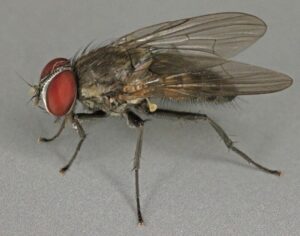
Credit: Janet Graham |
- The brown-grey thorax has three black, longitudinal stripes in the males.
- The eggs are white with a pair of dorsal longitudinal flanges or wings.
- The larvae are flattened, spiny, and about 7 mm long when fully grown.
Life Cycle and Common Characteristics
- These flies usually appear in the early spring before house flies become numerous.
- It is best known for its habit of entering buildings and flying in jagged patterns in the middle of a room.
- Females lay their eggs in batches of up to 50 (lay up to 2,000 eggs altogether).
- Eggs are laid on decaying vegetable matter and excrement, particularly that of chickens, humans, horses, and Eggs can float in liquid and semiliquid decaying organic matter.
- Eggs hatch within 1 to 2 days.
- Larvae feed on all manner of decaying organic matter, including carrion.
- Larvae require at least 6 days to reach pupation.
- Pupation lasts for at least 7 days.
- The pupal period lasts about seven days under favorable conditions.
- The complete life cycle requires 15 to 30 days, depending upon temperature.
- These flies have about seven generations per year.
- They are often found on excrement and on vertebrate animals. Because of their movements between excrement and human food, they are considered disease carriers.
Damages and Medical Implications
- From May to October, these flies come frequently into buildings and are noticeable around lamps. During night hours, the flies sit on lamps or on walls and leave their small excrement marks.
- Phorid Fly or Humpbacked Fly:
General Description
| · Adult phorid flies are 0.5–5.5 mm long with an enlarged thorax that gives them a characteristic humpbacked appearance.
· The hind femora are flattened, and the major bristles of the head and legs are feathered. They run in short, quick bursts and are usually found in damp places near larval habitats. |
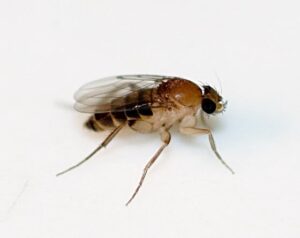
Credit: Charles Schurch Lewallen – bugguiude.net |
- Larvae are less than 10 mm long, lack an apparent head, and possess abdominal projections that range from being inconspicuous to large and
- They often run and stop repeatedly before taking wing, giving them another common name, “scuttle ”
Life Cycle and Common Characteristics
- The phorid fly’s life cycle is complete metamorphosis and it can grow from egg to adult within 14 to 37 days, depending on
- Eggs are laid on or beside moist decaying
- Breeding mediums for larvae are decomposing plant and animal matter, fungi, bird nests, feces, dead insects, sewage treatment beds, and commercial mushrooms.
- Phorid flies have an amazing ability to penetrate the soil to locate breeding They can even penetrate six feet or more of soil to infest caskets, earning them still another common name, the “coffin fly.”
- Another breeding source of these flies is soil that is contaminated by leaks around sewer If leaks are noticed in buildings, they can lead to severe indoor fly infestations.
Damages and Medical Implications
- The phorid fly is considered a minor pest that invades human dwellings occasionally.
- They cause a considerable level of nuisance and disease transmission
- They can spread harmful bacteria onto exposed food items or food processing surfaces inside food
- Phorid flies are frequent pests in cemeteries and mausoleums where they develop in liquid wastes associated with
- Sand Fly, No-See-Ums, or Black Gnat:
General Description
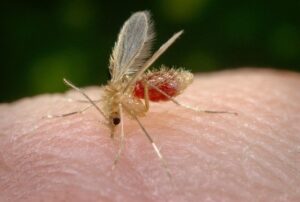 |
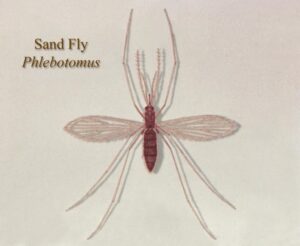 |
- Sand flies follow the Psychodidae family, and they are small flies that do not exceed 5 mm in length. This family includes several hundred species.
- The adult is 2-3 mm long and dull in color.
- The wings have a special shape and have nine or more long veins.
- The body is covered with thick hair, and that is why it is sometimes called moth flies.
- The proboscis is short, mutated for piercing and sucking in females, and it is sucking only in males.
- The chest is convex, the legs are long, and the wings have pointed tips covered with hair, and they rise upward at an angle of 45 degrees when at rest.
- The abdomen in the adult insect is elongated and cylindrical in the male and ends with a pair of handles, while in the female the abdomen is swollen and ends with a pair of anal horns.
- The eggs are elongated in shape, dark in color, with a frilled outer edge.
- The larva has a small head and biting mouthparts. The body rings bear serrated bristles, and the last abdominal rings carry four longitudinal bristles.
Life Cycle and Common Characteristics
- Sand flies breed under stones, between cracks, in stables, and in burrows of animals, especially rodents, where there is adequate darkness and humidity, and sufficient amounts of organic matter on which the larvae feed.
- These places play an important role in the epidemiology of diseases transmitted by sandflies, as some rodents are considered reservoirs for the parasite (Leishmania tropica) that causes oriental sore, which is transmitted by this fly.
- Females lay eggs in small groups, and they hatch after 35 days in summer and 710 days in winter. Small white larvae with long anal spines emerge, and their mouth parts are of the biting type.
- The larvae begin feeding on organic matter such as the moist feces of lizards and mammals, and the decaying matter of various plants.
- The larva turns into a pupal after two weeks. The pupal stage takes about 10 days, after which the whole fly emerges. In appropriate conditions, females lay their eggs after 5-7 days, thus the life cycle from laying eggs to laying them again takes 6-7 weeks in summer, and this period is longer in cold regions where the insect spends its winter hibernation in the last larval stage.
- There is no evidence of hibernation in hot regions.
Damages and Medical Implications
- The sandfly is active on quiet nights after sunset until midnight.
- Females suck the blood of humans and animals and their tingling is painful they are called “silent flies” because they do not make an audible buzz.
- The insect, due to its small body, is able to penetrate the holes of mosquito nets and wire mesh, whose number of holes is less than 45 holes / square inch (2.5 cm).
- Among the diseases transmitted by this insect are Leishmaniasis, which is a disease caused by a parasite of the genus Leishmania. This parasite infects humans, dogs and other mammals. Sand flies are the intermediate host for this parasite.
- 11. Stable Fly:
General Description
| · Stable fly resembles the house fly with 4- to 7-mm long, generally gray with a greenish-yellow sheen, four black stripes on the thorax, the outer two of which are broken, and black blotches or checkering on the abdomen.
· Unlike the housefly, where the mouth part is adapted for sponging, the stable fly mouthpart has a piercing/sucking type. |
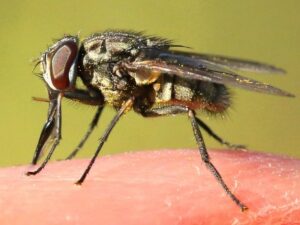
Credit: Peterwchen |
- The stable fly can easily be distinguished from the other common domestic flies by the long, pointed proboscis that extends in front of the head.
- The clear wings of the stable fly are iridescent, and the proboscis is slender, projecting in front of the
- The stable fly is so named because of its close association with domestic animals in stables. It is sometimes called the “biting house fly” because
- of its similar appearance to the common house fly, and “beach fly” because of their abundance in some beach areas.
Life Cycle and Common Characteristics
- Stable flies are commonly found around stables and houses, and also along the seashore, and near dog kennels. In these last two areas, they are frequently called biting beach flies and dog flies.
- Stable fly lays eggs in clusters of 20–100 on the ovipositional
- Ovipositional substrates include decaying vegetation, excluding dung unless it is comprised of or mixed with vegetation or dropped onto vegetation.
- The breeding medium must be moist, fermentation can improve larvae
- Examples of substrates in which the pest develops include decaying hay, alfalfa, silage, sugarcane, beached sea grass, lawn cuttings, compost, and piles of waste
- Cattle manure is sometimes utilized by stable flies for oviposition where high summer temperatures cause exposed manure to dry and develop a crust on the surface, sealing moisture within, thereby creating a relatively long-term, insulated
- Typically, a female lays eggs in 4–5 batches up to 20 times and can lay from 60–800 eggs during their Eggs hatch in 2–5 days at 26°C (in 12 hours at higher temperatures)
- Eggs are laid in such places as decaying hay, straw, fermenting weeds, grass, and seaweeds.
- Emergent larvae, or maggots, bury themselves in the oviposition substrate to feed and to prevent
- After 12–26 days, third instars enter the drier parts of their habitat and pupate in the last larval skin.
- Most pupae produce an adult in 5–26 days, and the adult is ready to fly in less than one
- Adult maximum longevity is variable, from 72 days for females to 94 days for males under laboratory conditions but longevity is likely less than 2 weeks under field
- Adults begin mating in 3–5 days and females start laying eggs in 5–8 days.
- The average adult lives about 20 days.
Damages and Medical Implications
- Stable flies are primarily a problem in suburban and rural areas, where horses and other livestock are kept.
- They have medical and veterinary importance
- They are obligate blood feeders and attack people, pets, and agricultural animals for a blood
- Both males and females use their proboscis to pierce the skin of a host and suck blood. The bite is painful, and outdoor human activity may be curtailed when these flies are numerous.
- They are synanthropic, meaning that they utilize habitats and food sources created by human activities such as animal
- Stable flies have the ability to transmit the pathogens that cause diseases such as anthrax, equine infectious anemia (EIA), and anaplasmosis to animals has been


